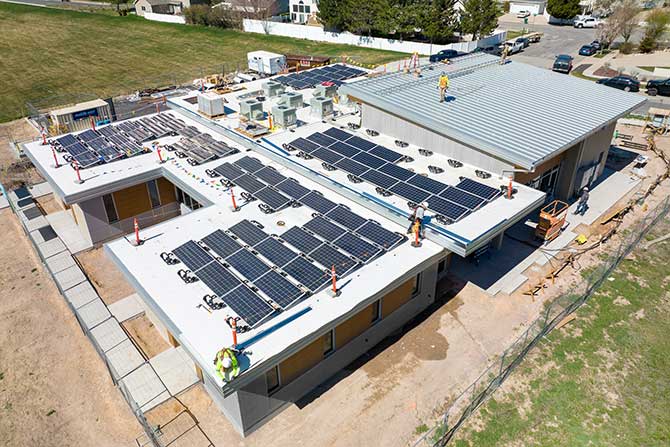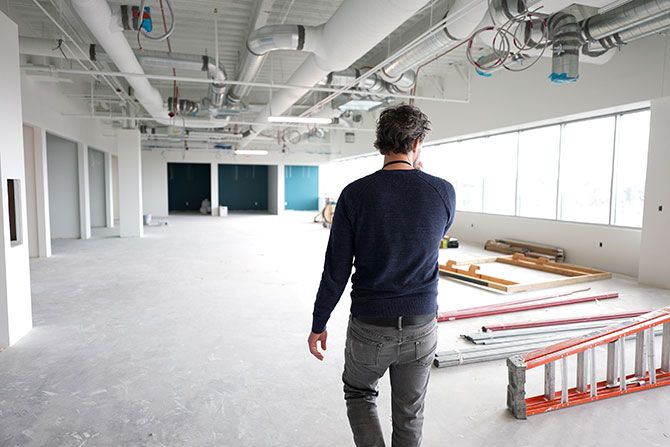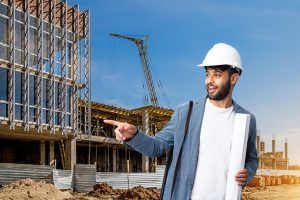By considering the entire life cycle of a structure, material or system, our buildings become smarter tools for making a positive impact on our clients as well as the environment.
Carbon is a well-known and researched contributor to our current climate, health, and sustainability challenges. Fully understanding its impact, however, is complicated. It takes looking into the entire lifespan of a product (or building) – from start to finish – to truly comprehend carbon’s effect.
Take a typical white T-shirt, for example. A shopper might narrow their choice to two options: one made of 100% traditional cotton and the other an eco-friendlier blend of cotton and recycled material. Despite a larger price tag, the shopper purchases the eco-friendly option – a small environmental victory with a simple purchase.
The truth of this sale, however, is much more layered. Possibly, the “eco-friendly” shirt’s sustainability ends in its marketing and material. Maybe this T-shirt’s lifespan started in a fossil-fueled textile plant on the other side of the world and shipped for days just to get on the rack. Conversely, the 100% cotton option may have been manufactured in a renewable-fueled textile plant much closer to home. In other words, not all materials, products, and services are created equal. The same is true in the architectural world, yet with larger consequences.
There are two fundamental parts of the carbon issue – operational carbon and embodied carbon.
Operational carbon is the carbon needed to sustain a building after completion. Renewable energy sources, products with higher thermal properties, and more efficient electrical and HVAC systems are all important solutions to operational carbon. They have come a long way, yet they only address half of the problem.
Embodied carbon refers to the “greenhouse gas emissions that arise from the manufacturing, transportation, installation, maintenance, and disposal of building materials,” according to the Carbon Leadership Forum (CLF). This kind of carbon is often overlooked because it’s less apparent, but it’s projected that from now until 2050, more than half of all construction-related emissions will be in the form of embodied carbon.
Analyzing a building’s entire life cycle is critical in calculating both its operational and embodied carbon impact. Life Cycle Assessment (also known as Life Cycle Analysis, LCA, Cradle-to-Grave Analysis, or Eco-Balance) is a tool to document and predict both. For architects, “life cycle assessment (LCA) is one of the best mechanisms for allowing architects and other building professionals to understand the energy use and other environmental impacts associated with all phases of a building’s life cycle: procurement, construction, operation, and decommissioning.”
Below is a breakdown of the Life Cycle Assessment process and what we, as designers, can do to reduce both operational and embodied carbon at each phase.
Procuring Raw Materials
It all starts in the “cradle” – with the extraction of raw materials from the earth. This can vary in form, from cutting down forests and vast mono-culture crops to deep pit mines and quarries. These processes impact water supplies, soil degradation, biodiversity loss, ecosystem functions, and produce extreme amounts of carbon emissions.
Improving carbon impacts in this phase can look like:
- Investigating where materials are coming from and how they are extracted from the earth;
- Choosing sources that implement friendlier tactics in extracting materials; or
- Selecting materials in your design that have less harsh procurement impacts on the environment or require fewer steps in extraction.
Transportation
Gone are the days when a building is constructed primarily of materials sourced nearby – lumber may come from Austria, steel perhaps from China and glass from opposite ends of the United States. Shipping materials across the world is no small deal. Transportation influences the life cycle of a building at multiple stages, such as transporting a raw material to be refined, moving that material to be manufactured or assembled into a workable product, moving it to a site, and once the material is decommissioned, relocating it to a landfill or recycling plant.
As architects designing for environmental health, we must consider sourcing and looking for alternatives that offer a comparable product but at a much closer proximity. For example, CRSA’s team was recently tasked with finding a stacking glass wall system for a project. Some of the most popular options come from Europe, meaning their carbon impact is much larger than something sourced in the United States. In addition to landing on an option closer to home, our team worked to have the glass sourced closer and installed on-site.
Improving carbon impacts in this phase can look like:
- Selecting materials or products that are as local as possible;
- Seeking out components of a product that can be assembled or sourced locally;
- Comparing transportation methods and looking for the “greener” option;
- Dialing in amounts to ensure deliveries are as efficient as possible; or
- Finding locations to dispose of or recycle materials that are closer to home.
Manufacturing & Refining
Manufacturing, refining, and assembling raw materials into usable items such as steel, glass, and lumber contributes to around 30% of all global CO2 emissions. However, the good news is that many large and small manufacturers are making great strides to become more efficient and environmentally conscious. These important changes include:
- Addressing sustainability in a coordinated, integrated, and formal manner rather than in an ad hoc, unconnected, and informal manner;
- Focusing on increased competitiveness and revenues rather than primarily focusing on cost-cutting, risk reduction, and improved efficiency;
- Using innovation, scenario planning, and strategic analysis to go beyond compliance;
- Integrating sustainability across business functions;
- Focusing more on the long term; or
- Working collaboratively with external stakeholders.
As members of the AEC community, we are responsible for investigating these manufacturers. Cost and product quality are often the two driving factors in making these decisions, yet, when possible, one should consider the points above to make a more well-rounded and conscious decision.
Construction & Installation
Emissions from vehicles such as trucks, welding equipment, cranes and the energy needed to power construction all leave their mark, contributing about 10-20% to overall emissions. Waste in materials, energy, and byproducts of construction all factor in, as well as the direct impact construction has on surrounding natural ecosystems. The science and techniques behind these processes are in flux, becoming more sustainable year after year, including:
- Limiting fuel usage by reducing vehicle idling, minimizing haul distances, using green or hybrid fuel sources;
- Properly disposing of construction waste and byproducts;
- Utilizing reusable technology;
- Expediting construction time; or
- Minimizing installation waste.
When designers prioritize these techniques, our impact becomes more powerful. Designers should consider how products are dealt with at end-of-life stages, how systems can be installed efficiently using a more standard process that is easy to repeat, or how the design might decrease construction time by eliminating time leeches that are avoidable or not crucial to the product.
Building Operations
According to Architecture 2030, 27% of all annual carbon emissions are sourced from building operations. By 2040, two-thirds of the global building stock will be made of existing buildings. In other words, the choices we make in today’s design of new buildings and retrofitting existing ones will have a significant impact for years to come.
HVAC systems, glazing, insulation, etc., all determine the performance of a building, with older systems understandably creating more pollution. Architecture 2030 also notes, “[f]or full building sector decarbonization, every existing building will need to undergo energy upgrades involving a combination of improvements in the energy efficiency of building operations, a shift to electric or district heating systems powered by carbon-free renewable energy sources, and the generation and/or procurement of carbon-free renewable energy.
Steps that can be taken toward this goal include:
- Integrating renewable and low-carbon technologies to supply energy needs, such as solar panels;
- Considering water recycling and how a building impacts adjacent stormwater and drainage systems;
- Updating antiquated heating and cooling systems;
- Recycling or reusing building maintenance materials;
- Upgrading older, inefficient window systems for alternatives that better maintain temperature fluctuation;
- Adapting building design to changing climate needs; or
- Replacing older lights with LED alternatives.
Building Demolition
Perhaps one of the biggest flaws in the design of today’s buildings is the inability to easily adapt them for new use. Often, little attention is paid to providing systems, materials, and spaces to ensure the building’s existence for centuries to come. Instead, the focus is placed on current needs.
According to a 2018 report by the EPA, 600 million tons of construction and demolition debris were generated in the United States. To mitigate the harmful effects of demolition, we can work with our clients to approach design for longevity and adaptability. This may mean designing more flexible spaces with easily adaptable interior spaces or, from the very beginning, thinking about how a building may be utilized in its community down the road after its original use has expired. Additionally, looking at materials that will hold up for decades or are more timeless in their use and appearance.
Recycling construction and demolition materials can help the impact of demolition waste. In 2018, 455 million tons of debris were reused in some form, such as material for construction aggregate, whereas 145 million tons were sent to landfills. Other benefits of reducing the disposal of debris include:
- Creates employment and economic activities in recycling industries and provides increased business opportunities within the local community, especially when deconstruction and selective demolition methods are used;
- Reduces overall building project expenses through avoided purchase/disposal costs and the donation of recovered materials to qualified 501(c)(3) charities, which provides a tax benefit. Onsite reuse also reduces transportation costs;
- Leads to fewer disposal facilities, potentially reducing the associated environmental issues;
- Offsets the environmental impact associated with the extraction and consumption of virgin resources and the production of new materials;
- Conserves landfill space; or
- Use bio-based and bio-degradable building materials.
Through Life Cycle Assessment, we unveil the hidden carbon costs of designing and constructing a building. As designers, we have an immense influence on this impact. Our design decisions have a far-reaching effect on environmental health and climate goals that can alleviate environmental disasters. By considering the total life cycle of a structure, material or system, our buildings become smarter tools for making a positive impact for our clients, as well as the places we live, work, and play.









